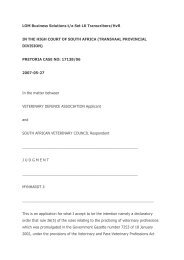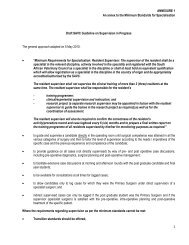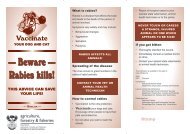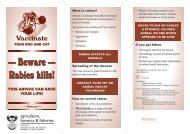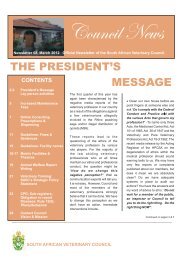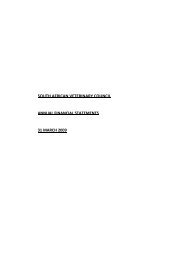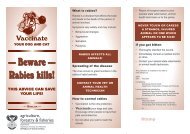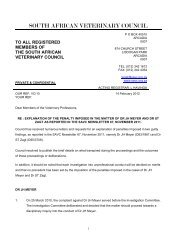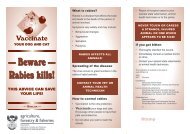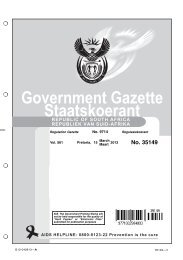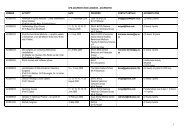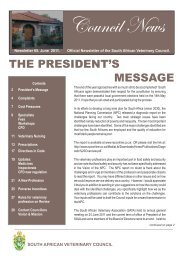Rabies Guide 2010.pdf - the South African Veterinary Council
Rabies Guide 2010.pdf - the South African Veterinary Council
Rabies Guide 2010.pdf - the South African Veterinary Council
You also want an ePaper? Increase the reach of your titles
YUMPU automatically turns print PDFs into web optimized ePapers that Google loves.
Diagnosing human rabies<br />
The clinical features of rabies, particularly in <strong>the</strong><br />
terminal stages of <strong>the</strong> disease, reflect <strong>the</strong> neural<br />
nature of <strong>the</strong> pathology. Conditions that cause an<br />
acute or subacute encephalopathic picture may be<br />
confused with rabies, <strong>the</strong>refore a definitive diagnosis<br />
is important to identify conditions amenable to<br />
<strong>the</strong>rapy.<br />
Clinical picture<br />
The highly variable incubation period of human<br />
rabies is a phenomenon that is not understood<br />
completely. 69,135<br />
Deep or multiple bites, particularly to <strong>the</strong> head and<br />
neck, may result in an incubation period of less than<br />
two weeks. However, incubation periods exceeding<br />
two years are also well documented. 136 Generally<br />
incubation periods seldom exceed 90 days and usually<br />
range between two and eight weeks, with 90% being<br />
less than six months.<br />
Nonspecific prodromal features last for one to<br />
four days and include fever, headache, malaise<br />
and nonspecific gastrointestinal symptoms.<br />
Neuropsychiatric symptoms, including irritability,<br />
depression, anxiety and insomnia, may be present.<br />
Sensory symptoms at <strong>the</strong> bite site, which has usually<br />
healed, are commonly experienced and may include<br />
intense pruritis, paraes<strong>the</strong>sia or pain.<br />
Following <strong>the</strong> nonspecific prodromal symptoms is a<br />
period lasting one to six days during which neurological<br />
signs and behavioural symptoms dominate. These<br />
include agitation and restlessness, incoherent or<br />
illogical speech and psychomotor hyperactivity,<br />
including episodic terror, hallucinations and manic<br />
behaviour, or generalised convulsions that may be<br />
triggered by various sensory stimuli. A remarkable<br />
and tragic feature distinguishing rabies from o<strong>the</strong>r<br />
acute encephalopathic neurological conditions are<br />
<strong>the</strong> lucid periods during which patients are well<br />
orientated.<br />
As <strong>the</strong> disease continues <strong>the</strong>re is progressive loss of<br />
neurological function. This is characterised by an<br />
inability to swallow (dysphagia), speech involvement<br />
(dysarthria), hypersalivation and spasms of <strong>the</strong><br />
involuntary musculature with resultant classical<br />
hydrophobia, or fear of water. 136 Aerophobia,<br />
following exposure to air movement, is ano<strong>the</strong>r<br />
typical symptom. Focal neurological abnormalities are<br />
surprisingly rare, while tachycardia and hyperpyrexia<br />
are more frequent. Convulsions and muscular<br />
spasms become prominent as <strong>the</strong> patient’s mental<br />
state deteriorates with progressive disorientation,<br />
hallucinations, confusion and coma.<br />
O<strong>the</strong>r clinical presentations include priapism, excessive<br />
libido and spontaneous pneumomediastinum. 137,138,139<br />
Patients usually die within five days of disease onset<br />
as a result of progressive cardio-respiratory failure,<br />
often preceded by obvious central nervous system<br />
respiratory irregularity. Progression to a nonreactive<br />
electroencephalograph (EEG) or sudden demise<br />
during a generalised seizure are common terminal<br />
events.<br />
Occasionally <strong>the</strong> agitated phase is absent and<br />
progressive paralysis as a result of spinal cord affectation<br />
is <strong>the</strong> prominent feature. 140 This may be asymmetrical,<br />
particularly affecting <strong>the</strong> limb that was bitten, or<br />
may mimic acute flaccid paralysis with symmetrical<br />
ascending paralysis and sphincter involvement but<br />
with accompanying sensory disturbance. Death from<br />
respiratory and bulbar paralysis in this form of rabies<br />
usually follows a longer period of clinical illness than<br />
seen with furious rabies.<br />
Common complications include respiratory arrest,<br />
pneumonitis, hypoxia because of ventilation-perfusion<br />
abnormalities, cardiac arrhythmia, interstitial<br />
myocarditis, posterior pituitary disorders, internal<br />
hydrocephalus and gastrointestinal bleeding.<br />
Although <strong>the</strong>re have been reports of human survival<br />
despite clinical disease, less than half a dozen are<br />
accepted as au<strong>the</strong>ntic, and intensive supportive<br />
hospital care appears to have been an essential element<br />
in each of <strong>the</strong>se cases. 141,142,143 In <strong>South</strong> Africa and<br />
similar developing countries where medical attention<br />
is usually sought late and sophisticated intensive care<br />
facilities are not available, most patients succumb<br />
within one to three days of hospital admission. 136<br />
42



